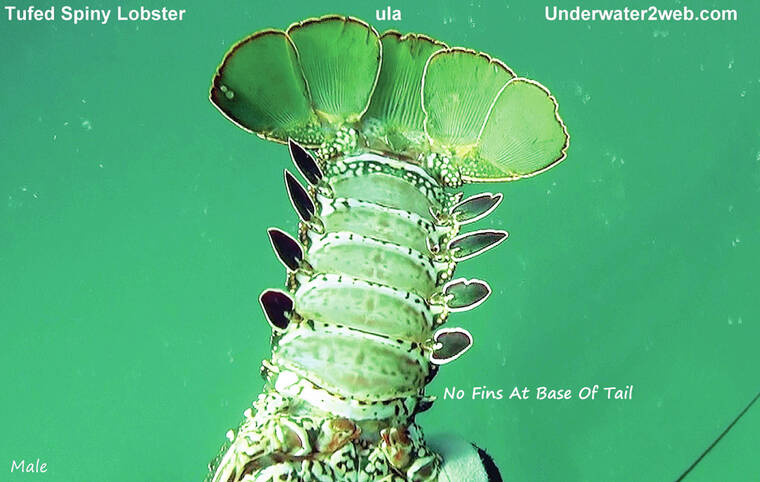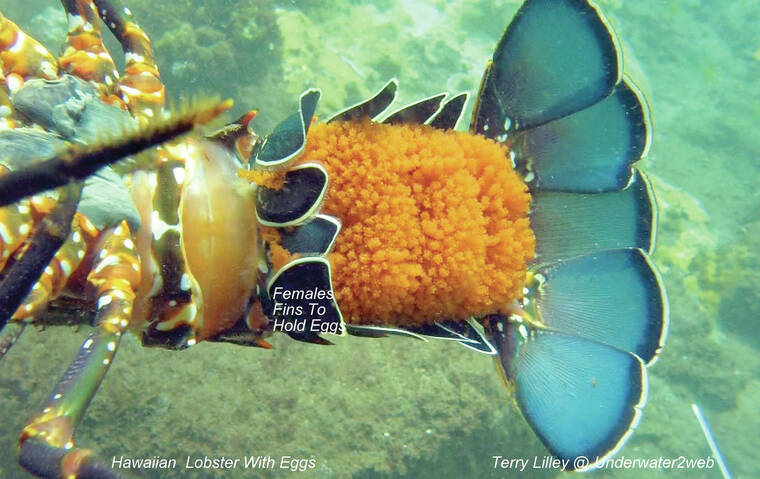Catching your own lobster for dinner is fun and also saves a lot of money from buying one in the store.
In Hawai‘i, we have more than 10 species of lobsters, but only three of them are commonly caught for food. We have two species of large spiny lobsters and several slipper lobster species that are large enough to catch and eat.
All of the lobsters when eaten fresh are very good. Our lobsters do not have the large front claws like the East Coast mainland lobsters that you see sold in restaurants. but they taste just as good.
The reason our native Hawaiian lobsters are not sold in restaurants is they are just too hard to catch on a regular basis. Hawaiian lobsters live out on the jagged reef in holes and caves under the surf. It is hard to trap them because the waves and sharks would tear up the traps.
White tipped reef sharks like lobsters as much as we do and would destroy a metal trap if their dinner was inside, so us humans have to catch the lobsters just like they do by chasing them around at night and grabbing them. It is not legal in Hawai‘i to spear lobsters, so we have to catch them by hand which is very difficult.
Our lobsters are active at night, so you have to go out into the surf at night and try to catch them when they have the advantage because they swim fast going backward by flapping their large tails. Anyone that catches lobsters in Hawai‘i knows that the lobster usually gets away and the diver ends up with cuts and bruises from getting tumbled in the surf on the reef at night.
Lobsters are called ula in Hawaiian, which means red and that is because all lobsters turn red when you cook them. Our laws in Hawai‘i allow us to catch lobsters most of the year except in the summer when they are breeding. But we are only allowed to catch male lobster, not females.
The problem is most people can’t tell a male lobster from a female lobster so this presents a problem. I once asked one of our Department of Land and Natural Resource agents if he could tell the difference between a male and female lobster. He said, “I have no idea how to sex them,” so I made a short movie for the agency showing how to sex Hawaiian lobsters.
Lobsters all around the world are sexed in the same way. You have to catch one and turn it over to look at the underside of the tail.
The females lay thousands of eggs and once the eggs are fertilized by a male, the female holds them under her tail until they hatch. The eggs are bright orange so they are easy to see. The female holds the eggs under her tail with an extra set of fins that go across the base of her tail. The males lack this extra set of fins and only have fins along the side of their tail.
Lobsters that live in areas, where there is a jagged reef and lots of surf, are a sustainable food source because they are very difficult to catch and they feed on algae and dead animals so there is always a lot of food for them to eat.
Some lobster species, like slipper lobsters and U.S. Maine lobsters, live out on the flat seafloor and can be easily overfished using traps. So it is important to know the sex of a lobster and also where it is caught to decide if it is a food that can be eaten without upsetting the balance of nature in any given area.
You can see lots of lobsters in action at night in my movie about the critters that come out at night on the Hawaiian coral reef up on my YouTube channel at Underwater2web.
•••
Terry Lilley is a marine biologist living in Hanalei Kaua‘i and co-founder of Reef Guardians Hawai‘i, a nonprofit on a mission to provide education and resources to protect the coral reef. To donate to Reef Guardians Hawaii go to www.reefguardianshawaii.org.






